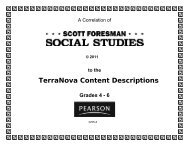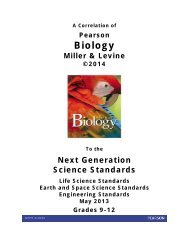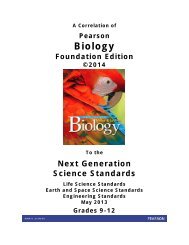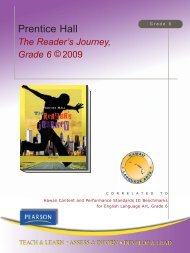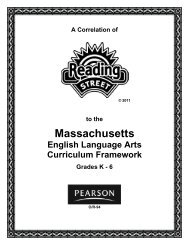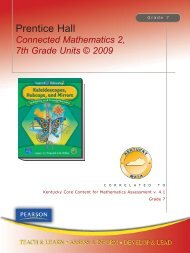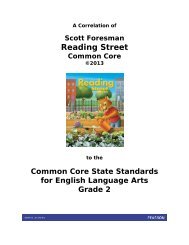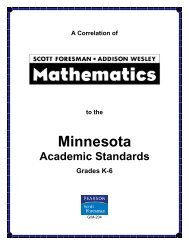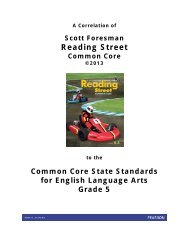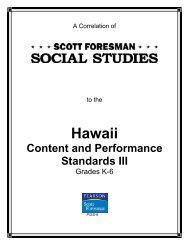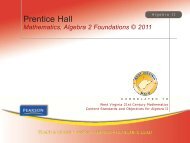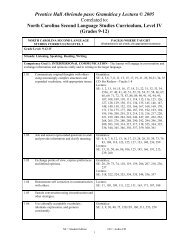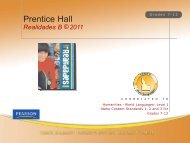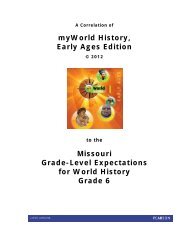Prentice Hall Science Explorer â 16 Book Series © 2009 ... - Pearson
Prentice Hall Science Explorer â 16 Book Series © 2009 ... - Pearson
Prentice Hall Science Explorer â 16 Book Series © 2009 ... - Pearson
Create successful ePaper yourself
Turn your PDF publications into a flip-book with our unique Google optimized e-Paper software.
<strong>Prentice</strong> <strong>Hall</strong> <strong>Science</strong> <strong>Explorer</strong> – <strong>16</strong> <strong>Book</strong> <strong>Series</strong> © <strong>2009</strong><br />
Correlated to:<br />
Connecticut Core <strong>Science</strong> - Content Standards and Expected Performances<br />
(Grades 6-8)<br />
CONNECTICUT CORE SCIENCE - CONTENT<br />
STANDARDS AND EXPECTED<br />
PERFORMANCES<br />
Expected Performances<br />
C12. Explain the relationship among force,<br />
distance and work, and use the relationship<br />
(W=F x D) to calculate work done in lifting<br />
heavy objects.<br />
C13. Explain how simple machines, such as<br />
inclined planes, pulleys and levers, are used<br />
to create mechanical advantage.<br />
PAGE(S) WHERE TAUGHT<br />
(If submission is not a text, cite<br />
appropriate resource(s))<br />
Motion, Forces, and Energy<br />
SE/TE: 108-113, 114-123; Discover Activity:<br />
108, 114; Key Terms: 108, 114; Math<br />
Analyzing Data: 119; Math Problem: 112,<br />
120; Math Practice: 113, 121; SciLinks.org:<br />
scn-1341, scn-1342; Skills Lab: 122-123;<br />
Target Reading Skills: 108, 114; Try This<br />
Activity: 111, 1<strong>16</strong><br />
TE: Address Misconceptions: 106F, 118; Build<br />
Inquiry: 112, 1<strong>16</strong>, 118, 120; Differentiated<br />
Instruction: 109, 115, 119; Monitor Progress:<br />
109, 111, 113, 115, 117, 119, 121; Teach<br />
Key Concepts: 109, 110, 111, 115, 119; Use<br />
Visuals: 117<br />
Motion, Forces, and Energy<br />
SE/TE: 124-135, 138-139; Active Art: cgp-<br />
3043: 133; Discover Activity: 124; Discovery<br />
Channel School Video Field Trip: 128; Figure:<br />
133; PHSchool.com: cgh-3040: 139; Key<br />
Terms: 124; <strong>Science</strong> and History: 130-131;<br />
Section Assessment: 135; <strong>Science</strong> and<br />
Society: 138-139; Skills Activity: 132; Skills<br />
Lab: 126-127; Target Reading Skills: 124;<br />
Try This Activity: 127; Writing in <strong>Science</strong>:<br />
131<br />
TE: Address Misconceptions: 106F, 132;<br />
Background: 130-131, 138; Build Inquiry:<br />
129, 131, 133; Differentiated Instruction:<br />
125, 129; Monitor Progress: 125, 126, 129,<br />
131, 133, 135; Performance Assessment:<br />
135; Teacher Demo: 126; Teach Key<br />
Concepts: 125, 126, 127, 128, 129, 132, 134<br />
C14. Describe how different types of stored<br />
(potential) energy can be used to make<br />
objects move.<br />
Motion, Forces, and Energy<br />
SE/TE: 146-150, 151-157, 158-<strong>16</strong>3; Active<br />
Art: cgp-3053: <strong>16</strong>0; At Home Activity: <strong>16</strong>3;<br />
Discover Activity: 146, 158; Key Terms: 146,<br />
158; Math Skills: 148; SciLinks.org: scn-<br />
1351, scn-1352; Target Reading Skills: 146,<br />
151, 158<br />
38<br />
SE = Student Edition - TE = Teacher Edition



